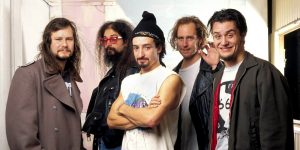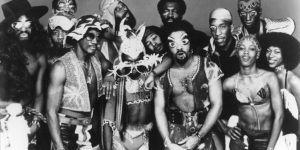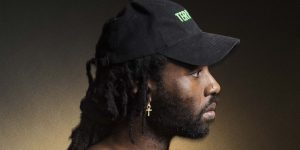CRAM SESSION: An intro to fuzz rockers Dinosaur Jr.
by Cam Lindsay
August 3, 2016
Following breakups, makeups and endless innovations, here’s where to start with Dinosaur Jr.’s thirty year career.
For every kid who grew up listening to indie rock in the ’80s and ’90s, J Mascis was the guitar god to impersonate while air guitaring in front of the mirror. Between his sludgy, pedal-boosted shredding and his extended solos that franticly surfed up and down the fret board, Mascis’ instrumental prowess turned Dinosaur Jr. into one of the most influential bands of their generation. Inspired by greats like Greg Sage, Neil Young, Ron Asheton and Tony Iommi, Mascis developed a unique guitar sound of his own for Dinosaur Jr. that became instantly recognizable, along with his inimitable lazy drawl.
Although he is often regarded as a guitarist first and a songwriter second, Mascis has spent the better part of three decades writing the bulk of Dinosaur Jr.’s albums with remarkable consistency – even after a ten-year hiatus. While some Dino Jr. records are better than others, Mascis, along with founding bassist Lou Barlow (who left the band in 1989 and found success with bands like Sebadoh and the Folk Implosion) and drummer Patrick “Murph” Murphy, were one of the first bands to prove that reunions don’t have to be just about playing the hits for a couple of tours. When the original line-up returned in 2005 to play some shows, they followed it up two years later with a brand new album, Beyond, which picked up where they left off nearly 20 years prior.
Dinosaur Jr. are now releasing their fourth album since the gang got back together, and to no one’s surprise, Give a Glimpse of What Yer Not is yet another testament to this band’s ability to age with greatness. Here is a look at the key albums that got them to this point.
Dinosaur (1985)
Before Dinosaur, Mascis drummed and Barlow played guitar in Amherst hardcore band Deep Wound. When that band split up, Mascis had a collection of songs he wanted to record as vocalist and guitarist. He enlisted Barlow on bass and friend Emmett Patrick Murphy on drums and they named the band Dinosaur. Another friend Gerard Cosloy had launched an imprint called Homestead that had released music by Big Black, the Meatmen and Naked Raygun. He offered to release Dinosaur’s record, which Mascis had described as “ear-bleeding country.”
On the self-titled debut album, the band were still searching for their sound, turning in an uneven, mixed bag that laid out their influences – country and folk rock (“Forget the Swan,” “Severed Lips”), hardcore punk (“Mountain Man,” “Does It Float”) and metal (“The Leper”) – but failed to indicate exactly what direction the band were headed in. However, album standout “Repulsion” hinted at what would become the band’s signature sound with its mid-tempo rhythm, swirling guitar distortion, and buried melodies.
You’re Living All Over Me (1987)
The leap from Dinosaur to You’re Living All Over Me was a sizeable one. Not only was it their first for SST, on this album the band found their footing and recorded what is still widely considered their best work to this day. Produced by NYC legend Wharton Tiers, You’re Living took all of those aforementioned influences and fashioned a distinct sound built around J’s noisy, effects-laden guitar that would go on to be mimicked and stolen by countless bands (Pavement, Broken Social Scene, My Bloody Valentine, Raisanbag) for years to come.
But this was as much about the band writing killer cuts, as it was defining the indie rock genre. The blizzard of wah noise and guttural screams that open “Little Fury Things” simply subsides to one of the band’s best ever melodies and J’s languid vocal that sing a lyric I will never understand. Perhaps his best ever example of letting rip on the guitar comes on “Sludgefeast,” a twisting assault of Crazy Horse-like riffage that ebbs and flows, finally ending with a coda that turns the song upside down. And of course, there is “In A Jar,” a precious call out from a pet to its troubled owner that demonstrated J’s penchant for writing curious love songs.
Not to be outdone – and often that seemed like the case – was Lou Barlow’s two contributions. The rambunctious “Lose” and the stripped down acoustic “Poledo” paved the way for his future endeavours as a lo-fi god. Both songs could have easily been saved for a Sentridoh or even Sebadoh release, but the fact that they were designated as Dinosaur songs is perhaps why they’ve remained so special.
Of course, once the album was done, pressed and sent out to shops, a cease-and-desist letter arrived from a bunch of old hippies who went by the name the Dinosaurs. And so, Dinosaur Jr was born.
“Just Like Heaven” (1987)
Dinosaur Jr. have recorded a number of covers over their 30-plus years – David Bowie’s “Quicksand,” KISS’ “Goin’ Blind,” Guns N’ Roses’ “Sweet Child O’ Mine” and the Flying Burrito Brothers’ “Hot Burrito #2” to name a few – but their 1987 cover of the Cure’s “Just Like Heaven” isn’t just their best known cover, it’s one of their most recognizable songs. Originally recorded for a compilation, the band opted out and chose to release it as a single for SST in 1989. It became a mainstream hit for the band in the UK and even earned high praise from Robert Smith himself, who later told Blender, “J Mascis sent me a cassette, and it was so passionate. It was fantastic. I’ve never had such a visceral reaction to a cover version before or since.”
Bug (1988)
Even though J Mascis is admittedly not much of a fan, Dino Jr.’s third album played a vital role in the band’s history. On Bug, Mascis assumed the producer role and searched for a cleaner sound. However, by going cleaner, Dino Jr. didn’t relent their trademark noise; the band still surrounded themselves with wall-to-wall noise, only now could you come closer to deciphering J’s warbled lyrics.
Bug is significant for two simple reasons. The first being that it leads off with what is arguably Dino Jr.’s finest moment: “Freak Scene.” The song was one of the most influential of its time, giving an anthem to the weirdoes, the slackers and especially the indie rock genre. It also did really well on the UK indie singles chart, setting up a #1 position on the albums chart for Bug upon its release. Read between the lines and you can see that “Freak Scene” was quite possibly an open letter from Mascis to Barlow, who weren’t getting along.
Which brings us to the second reason: it marked the last album to feature Lou Barlow for nearly 20 years. Towards the end of Bug, Barlow screams the words “Why! Why don’t you like me?” over and over, as if he’s being torn apart limb from limb. The kicker is that Mascis actually wrote the song for him to sing, perhaps as one final way to humiliate the bassist, whom he was constantly griping with. According to Barlow, he was kicked out of the band in a pretty devious way: Mascis and Murph announced that Dino Jr. had broken up, only to turn around two weeks later with Barlow’s replacement, Donna Dresch, filling in for their Australian tour. And so, emo was born.
Green Mind (1991)
Following Barlow’s departure, Dinosaur Jr. went on a brief hiatus. In that time, Mascis nearly joined Nirvana, as he received an offer from Kurt Cobain, who was looking to ditch guitarist Jason Everman (another offer came to drum on Nirvana’s “Sliver”). But Mascis stuck by his band, and in 1990 they signed to Blanco y Negro, a subsidiary of major label WEA that was founded by Rough Trade’s Geoff Travis and included the Jesus & Mary Chain, the Dream Academy and Bananarama. The deal came right around the time that Sonic Youth had caused bedlam by signing to DGC.
Mascis recorded Green Mind almost all on his own. Murph appeared on only three tracks, and guests – Gumball’s Don Fleming, Sean Slade (producer on Radiohead’s Pablo Honey) and er, actor Matt Dillon – filled in as needed. Despite the one-man show, Mascis demonstrated his expertise as a producer, giving the songs an organic feel; gone is the suffocating distortion in return for a cleaner jangle on tracks like “The Wagon,” “Puke + Cry” and “Muck.” But the biggest revelation was ballads like “Playing Cloud” and the flute-led “Thumb,” which brought more nuance to the music.
It was far from the commercial hit the label was hoping for (#168 on the Billboard 200), but Green Mind struck a note with critics and a new audience that was beginning to discover the blossoming alternative rock scene that Sonic Youth, Pixies and Jane’s Addiction were fostering.
Green Mind may have arrived seven months before Nirvana’s Nevermind, but it’s safe to say that the album benefitted from its inclusion in the grunge movement – more because of an association with Nirvana and Sub Pop (who released album cut “The Wagon” as a single in 1990) than anything. Dino Jr. were also a part of David Markey’s generation defining film, 1991: The Year That Punk Broke, which featured the band on tour in Europe with Sonic Youth and Nirvana. The next year they joined another influential tour in the UK called Rollercoaster, which featured the Jesus & Mary Chain, My Bloody Valentine and Blur. Imagine that.
Where You Been (1993)
Dinosaur Jr.’s fifth album wasn’t as historically significant as any of its predecessors, but it was the first Dinosaur Jr. album that this author ever heard, so that’s something. Arriving at the peak of alternative culture, it’s no surprise that Perry Farrell invited them to join the 1993 Lollapalooza line-up, alongside Alice In Chains, Rage Against the Machine, Babes In Toyland and Primus, who bafflingly headlined the travelling festival.
Once again produced by Mascis, Where You Been contained some of the band’s most sharpened hooks to that point – the epic “Out There,” the head-nodding “Get Me,” and the peppy “Start Choppin’” – but truth be told, every song save the finale, “I Ain’t Sayin’,” felt twice as long as it should have been. As great as it is to hear J go soul-searching and shred away on “Out There,” I have always struggled to sit through the entire thing.
Where You Been did about the same as Green Mind with both CD and cassette buyers and critics, but it did produce the band’s most successful single, “Start Choppin’,” which was a favourite of MTV’s Buzz Bin. Although two more Dinosaur Jr. albums followed – 1994’s Without a Sound, featuring the fan favourite “Feel the Pain,” and 1997’s Hand It Over – Where You Been was the last to feature Murph, who left abruptly and went on to join the Lemonheads for their album, Car Button Cloth. Mascis put the Dino Jr. moniker on ice, opting to record under his own name with a new band, the Fog, as well as stoner metal band Witch and power-pop supergroup Sweet Apple.
Beyond (2007)
Hatchets were made to be buried, and in the early 2000s, J Mascis and Lou Barlow began communicating and even performing again. Oddly enough, they first reunited in 2005 to perform a Deep Wound reunion at a benefit show Barlow’s mother organized for autism awareness. But then news of a full Dinosaur Jr. reunion (including Murph on drums) emerged, followed by Merge Records’ reissue of the band’s first three albums. The first performance came on The Late Late Show with Craig Ferguson, followed by consecutive tours.
The chemistry was obviously back and relations were more civil than ever for the trio, and so touring led to recording. Beyond marked the first new album by J Mascis, Lou Barlow and Murph since 1988’s Bug. I wouldn’t say it sounded like they picked up right where they left off, because Beyond is three well-seasoned musicians making a far more cohesive and better executed album than anything that came before it. In the 19 years between the albums, each member obviously generated a substantial amount of music outside of Dinosaur Jr. (well, maybe not Murph), and that professionalism really rings through songs like J’s “This Is All I Came To Do” and Lou’s “Back To Your Heart.” And they kept the well-oiled machine going for three more albums, including the new Give A Glimpse Of What Yer Not.
With all of the animosity between Barlow and Mascis over the years, no one really expected Dinosaur Jr. to A) reunite on good terms, B) survive the initial reunion tour and make four more albums and counting, and C) be the band that reunited after 20 years to prove some of their best music was still to come. But they’ve done it so seamlessly it’s sometimes easy to forget they ever broke up in the first place.
Tags: Music, Featured, cram session, Dinosaur Jr., J Mascis, Lou Barlow, Primer, Sebadoh, Starter's Guide





